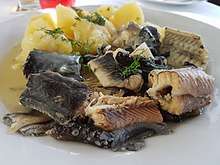Cuisine of Berlin
Cuisine of Berlin describes different aspects of Berlin's culinary offerings. On the one hand, it means the traditional Berlin cuisine of Berlin households with dishes such as Königsberger Klopse or Kassler and, on the other hand, often a rustic pub and snack kitchen, which has become increasingly international due to labor migration since the Second World War.[1][2] Since German reunification, numerous top-class restaurants have also been added.
History
Until the end of the 19th century, the Berlin kitchen was a simple kitchen, which emphasized hearty taste and saturation rather than refinement. In the 17th century, numerous Huguenots settled in Berlin and brought their cooking traditions with them.[3] The Prussian-Protestant kitchen integrated these influences essentially through simplification.
Typical ingredients were pork, goose and fish such as carp, eel and pike, cabbage, legumes such as peas, lentils and beans as well as beets, cucumbers and potatoes. What is striking - from today's perspective - is the frequent use of the noble crayfish, which made it possible to catch fish rich in Berlin in the 18th and 19th centuries.
With the founding of the German Empire, Berlin became the capital of a world empire and the arrival from different provinces expanded the city's cooking tradition, and Berlin cuisine began to internationalize. Jewish and Eastern European types of preparation were added, which expanded the menu in the capital.
In the 1920s, Berlin was one of the largest cities in the world. Numerous large hotels and restaurants offered different dishes.[4] The Nazi regime and the Second World War of annihilation that followed put an end to this culinary diversity. While in the eastern part, as the de facto capital of the GDR, the upscale gastronomy almost completely disappeared and international influences did not appear for decades, the restaurant scene in the west recovered slowly from this break.
The first restaurants for fine cuisine opened in the rebuilt City West after the war. During the division of Berlin, the delicatessen department of KaDeWe remained one of the largest of its kind in the world and is still very popular with city residents and tourists alike.[5]
The legendary Berlin currywurst is said to have been invented in 1949 by Herta Heuwer from Königsberg, who was running a small snack stand in Charlottenburg at the time.[6]
In 1958 the Café Kranzler opened on Kurfürstendamm, which wanted to follow the pre-war coffeehouse culture. The café established itself in the following years as a West Berlin institution.[7]
Due to the labor migration after the Second World War, the Berlin kitchen internationalized again. Turkish immigrants are said to have invented the doner kebab in Kreuzberg in the 1970s, which is now considered one of the most typical Berlin snacks.[8][9]
Since reunification at the latest, Berlin has been able to establish itself again as a metropolis for gourmets. Even in the former eastern part such as Mitte or Prenzlauer Berg, there are now numerous restaurants with international offerings.[10]
In 2017 there were a total of seven restaurants that were awarded two Michelin stars. Another 14 restaurants received a star. In 2017, Berlin was the city with the most star restaurants in German-speaking countries.[11]
Typical dishes
Meat dishes

- "Liver Berlin style" - Fried veal liver with onions and apple slices on mashed potatoes
- Eisbein - Pickled Ham Hock
- Currywurst
- Kassler - Salted and smoked roast pork
- Roast goose - Traditional Christmas dinner in many Berlin households
- Königsberger Klopse - Meatballs with anchovies and caper sauce
- Döner Kebab
Fish dishes
- "Aal Grün" ("Green eel") - Eel in herb sauce
 "Aal Grün" with potatoes
"Aal Grün" with potatoes - Rollmops - Pickled herring filets
- "Polish carp" - Carp in gingerbread sauce
Vegetable dishes and side dishes

- Kartoffelpuffer - Potato Pancake, often found at Christmas markets, sweet with apple sauce and sugar or hearty with salmon and cream horseradish
- Jacket potato with curd cheese and linseed oil
- "Teltower Rübchen" - caramelized and then braised turnips; served as a side dish with roast goose or duck, roast pork, Kassel cutlets, tongue or meatloaf
- Sauerkraut
- "Bratkartoffeln" - Fried potatoes, served as a side dish or main course with fried egg
Dessert
- "Berliner Luft" - ("Air of Berlin") White wine cream with raspberry sauce
- "Mohnpielen" - Bread pudding with poppy seeds
- "Rote Grütze" - Red fruit jelly
Bakery products
- Berliner Pfannkuchen - Lard pastries filled with plum jam
- Berliner Napfkuchen - Yeast cake with raisins
- Berliner Käsekuchen - Cheese cake made from curd cheese mass with raisins and rum on a short pastry base
- "Liebesknochen" (" Love Bone") - German word for Eclair
Beverages
Berlin has a long brewing tradition. The most common variety is Pilsener. Brands such as Schultheiss, Berliner Kindl and Berliner Pilsener are very popular across Germany. Typical for Berlin is the wheat beer Berliner Weisse, which in the summer months is often drunk as a Berliner Weiße mit Schuss: with raspberry or woodruff syrup through a straw in a characteristic glass.
References
- "Berlin cuisine". www.visitberlin.de. Retrieved 2020-05-12.
- "Berlin: History, Lifestyle and Home-Style Cuisine – Germanfoods.org". Retrieved 2020-05-12.
- "Huguenot Museum in the Französischer Dom". www.visitberlin.de. Retrieved 2020-05-12.
- "Berlin's Café Kranzler in name only". Walled In Berlin. 2017-07-10. Retrieved 2020-05-12.
- "KaDeWe". berlin.de. Retrieved 2020-05-12.
- www.thelocal.de https://www.thelocal.de/20190905/currywurst-a-product-of-the-british. Retrieved 2020-05-12. Missing or empty
|title=(help) - "Berlin's Café Kranzler in name only". Walled In Berlin. 2017-07-10. Retrieved 2020-05-12.
- "Döner Kebab ist eine Berliner Erfindung". berlin.de (in German). Retrieved 2020-05-12.
- Cichanowicz, Lily. "A Brief History Of The Döner Kebab". Culture Trip. Retrieved 2020-05-12.
- "Eating out in Berlin". www.visitberlin.de. Retrieved 2020-05-12.
- "Michelin starred restaurants". www.visitberlin.de. Retrieved 2020-05-12.
